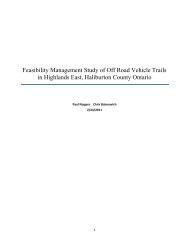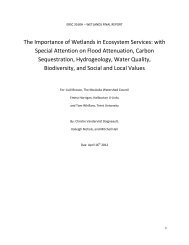Untitled - Haliburton County Community Cooperative Inc
Untitled - Haliburton County Community Cooperative Inc
Untitled - Haliburton County Community Cooperative Inc
- No tags were found...
Create successful ePaper yourself
Turn your PDF publications into a flip-book with our unique Google optimized e-Paper software.
state. Information was recorded on twenty species of fish including smallmouth, largemouth bass, andpanfish varieties, which are major draws of the Muskoka region fishing sector, as noted by the MNR, aswell as several prey species. In 18 of the 20 species, larvae and juvenile fish abundance were muchhigher in natural-state shorelines compared to developed ones (Bryan & Sarnecchia, 1992). Fish speciesbiodiversity was also greater in non-developed areas (Bryan & Sarnecchia, 1992). Bryan and Sarnecchiasuggest that the common practice of removing phragmites species in developed areas may be a majorpart of why natural shorelines are richer in fish abundance and diversity (Bryan & Sarnecchia, 1992).Removal of shoreline shoreline vegetation is destructive fish breeding and feeding grounds, and anessential habitat for stages of numerous species lives (Bryan & Sarnecchia, 1992).Eadie and Keast also produced similar results when comparing lakes in Southern to NorthernOntario. The study included species diversity comparisons, taking note of any developments causinghabitat complexity. Similar to the previous example studies, Eadie and Keast found species diversity toexcel on shorelines of most pristine conditions, as opposed to developed shorelines. This again supportsto need for integrity in shorelines in Muskoka region lakes to ensure fish habitats and water quality.Macrophyte communities are one of the most essential habitats for young fish, and keystonefish species. Macrophyte growths are also one least desirable aesthetically for many cottagers, and oneof the most common targets of habitat and shoreline destruction (Brown, 1998). Dredging and theexcavation of macrophytes is done to make room for docks, boathouses, swimming areas or to make aclearer view of the lake (Brown, 1998). However these areas are critical fish habitats, and bountifulenvironments in the health of a whole lake ecosystem. Macrophyte abundance in lakes can beassociated with high fish abundance and richness, and high nursery and reproductive success of fish(Brown, 1998). These littoral zones are important in juvenile fish growth and are also associated withhigh invertebrate abundance and richness, a main food source of juvenile and small fish species (Brown,1998). Macrophytes are also a key part of wind exposure protection. Several small species, juvenile fish26







